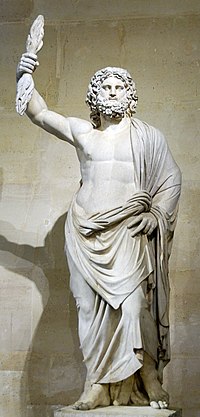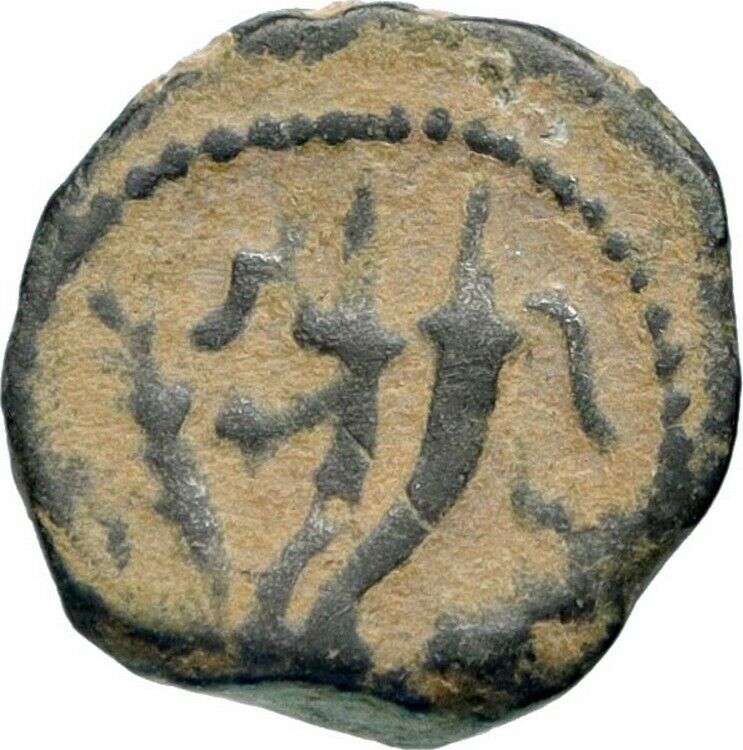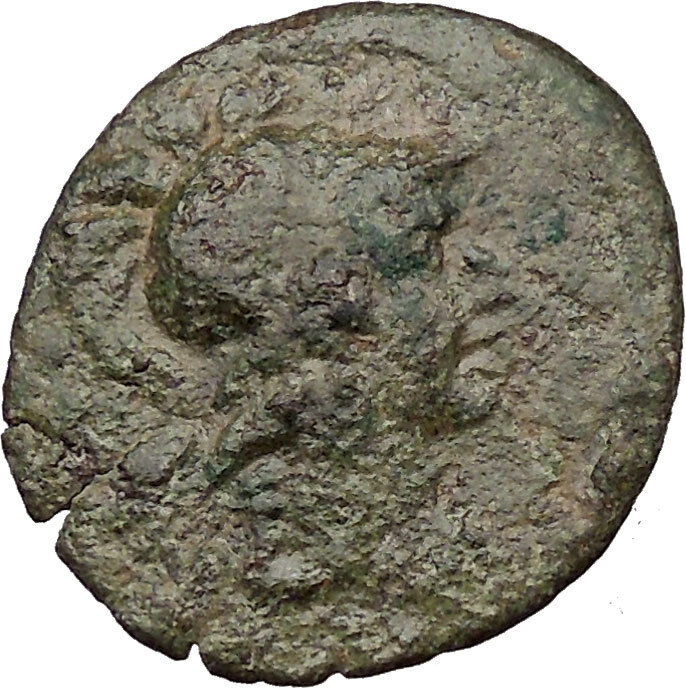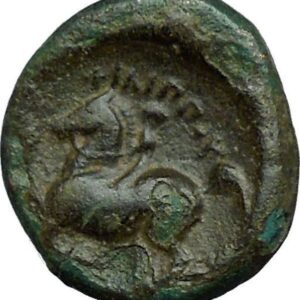|
Greek city of Kierion in Thessaly
Bronze 14mm (2.64 grams) Struck circa 400-344 B.C.
Reference: HGC 4, 679
Laureate head of Zeus right.
KIEP, Nymph Arne kneeling right, head turned left, playing knucklebones.
This town originally bore the name Arne after a local river nymph.
You are bidding on the exact item pictured, provided with a Certificate of Authenticity and Lifetime Guarantee of Authenticity.
 In the ancient Greek religion, Zeus was the “Father of Gods and men” who ruled the Olympians of Mount Olympus as a father ruled the family. He was the god of sky and thunder in Greek mythology. His Roman counterpart is Jupiter and Etruscan counterpart is Tinia. In the ancient Greek religion, Zeus was the “Father of Gods and men” who ruled the Olympians of Mount Olympus as a father ruled the family. He was the god of sky and thunder in Greek mythology. His Roman counterpart is Jupiter and Etruscan counterpart is Tinia.
Zeus was the child of Cronus and Rhea, and the youngest of his siblings. In most traditions he was married to Hera, although, at the oracle of Dodona, his consort was Dione: according to the Iliad, he is the father of Aphrodite by Dione. He is known for his erotic escapades. These resulted in many godly and heroic offspring, including Athena, Apollo and Artemis, Hermes, Persephone (by Demeter), Dionysus, Perseus, Heracles, Helen of Troy, Minos, and the Muses (by Mnemosyne); by Hera, he is usually said to have fathered Ares, Hebe and Hephaestus.
As Walter Burkert points out in his book, Greek Religion, “Even the gods who are not his natural children address him as Father, and all the gods rise in his presence.” For the Greeks, he was the King of the Gods, who oversaw the universe. As Pausanias observed, “That Zeus is king in heaven is a saying common to all men”. In Hesiod’s Theogony Zeus assigns the various gods their roles. In the Homeric Hymns he is referred to as the chieftain of the gods.
His symbols are the thunderbolt, eagle, bull, and oak. In addition to his Indo-European inheritance, the classical “cloud-gatherer” also derives certain iconographic traits from the cultures of the Ancient Near East, such as the scepter. Zeus is frequently depicted by Greek artists in one of two poses: standing, striding forward, with a thunderbolt leveled in his raised right hand, or seated in majesty.
 A nymph in Greek mythology and in Latin mythology is a minor female nature deity typically associated with a particular location or landform. Different from goddesses, nymphs are generally regarded as divine spirits who animate nature, and are usually depicted as beautiful, young nubile maidens who love to dance and sing; their amorous freedom sets them apart from the restricted and chaste wives and daughters of the Greek polis. They are believed to dwell in mountains and groves, by springs and rivers, and also in trees and in valleys and cool grottoes. Although they would never die of old age nor illness, and could give birth to fully immortal children if mated to a god, they themselves were not necessarily immortal, and could be beholden to death in various forms. Charybdis and Scylla were once nymphs. A nymph in Greek mythology and in Latin mythology is a minor female nature deity typically associated with a particular location or landform. Different from goddesses, nymphs are generally regarded as divine spirits who animate nature, and are usually depicted as beautiful, young nubile maidens who love to dance and sing; their amorous freedom sets them apart from the restricted and chaste wives and daughters of the Greek polis. They are believed to dwell in mountains and groves, by springs and rivers, and also in trees and in valleys and cool grottoes. Although they would never die of old age nor illness, and could give birth to fully immortal children if mated to a god, they themselves were not necessarily immortal, and could be beholden to death in various forms. Charybdis and Scylla were once nymphs.
Other nymphs, always in the shape of young maidens, were part of the retinue of a god, such as Dionysus, Hermes, or Pan, or a goddess, generally the huntress Artemis. Nymphs were the frequent target of satyrs.
Etymology
Nymphs are personifications of the creative and fostering activities of nature, most often identified with the life-giving outflow of springs: as Walter Burkert (Burkert 1985:III.3.3) remarks, “The idea that rivers are gods and springs divine nymphs is deeply rooted not only in poetry but in belief and ritual; the worship of these deities is limited only by the fact that they are inseparably identified with a specific locality.”
The Greek word νύμφη has “bride” and “veiled” among its meanings: hence a marriageable young woman. Other readers refer the word (and also Latin nubere and German Knospe) to a root expressing the idea of “swelling” (according to Hesychius, one of the meanings of νύμφη is “rose-bud”).
Adaptations
The Greek nymphs were spirits invariably bound to places, not unlike the Latin genius loci, and the difficulty of transferring their cult may be seen in the complicated myth that brought Arethusa to Sicily. In the works of the Greek-educated Latin poets, the nymphs gradually absorbed into their ranks the indigenous Italian divinities of springs and streams (Juturna, Egeria, Carmentis, Fontus), while the Lymphae (originally Lumpae), Italian water-goddesses, owing to the accidental similarity of their names, could be identified with the Greek Nymphae. The mythologies of classicizing Roman poets were unlikely to have affected the rites and cult of individual nymphs venerated by country people in the springs and clefts of Latium. Among the Roman literate class, their sphere of influence was restricted, and they appear almost exclusively as divinities of the watery element. Nymphs are also portrayed as selfish and as attention seekers who walk around naked in the middle of forests.

In this 1896 painting by John William Waterhouse, Hylas is abducted by the Naiads, i.e. fresh water nymphs

Echo, an Oread (mountain nymph) watches Narcissus in this 1903 painting by John William Waterhouse.

Sofades (Greek: Σοφάδες, Sofádes) is a town and municipality in Thessaly, central Greece belonging to the regional unit of Karditsa. Its 2011 census population was 6,056 people and 18,864 for the municipality, including a large Romani minority. Its elevation is around 120 m above sea level, and the economy is mainly agricultural (cotton, corn). It is the only municipality that has one municipal district with settlements. Sofades is located south of Palamas, southwest of Larissa, the capital of Thessaly, northwest of Lamia and southeast of Karditsa and Trikala. Sofades is on GR-30 (Karditsa – Domokos – Volos) as well as the road between Mataragka and Palamas. It is on the OSE railway line linking Kalambaka and the main line and has a station. The Greek inhabitants of the region are commonly known as Karagounides (Καραγκούνηδες).
History
The modern town is very close to the site of the ancient city of Kierion (Greek: Κιέριον) or Cierium, one of the most important cities of ancient Thessaly. The name “Sofades” was first recorded as “Sofou” (Σοφού) around 1454 AD. In the early 1800s the English traveler William Martin Leake described the town as an administrative center consisting of around 150 houses and belonging to Abdim Bey of Larissa, but paying a yearly tribute to Ali Pasha. Chief crops of the region were corn and sesame, from which the oil was a major product.
Much of the area is hilly and consists of farmland and woodland. Mountains lie to the south and east. A river flows to the north.
Ancient Thessaly or Thessalia (Greek: Αρχαία Θεσσαλία, Thessalian: Πετθαλία, Petthalia) was one of the traditional regions of Ancient Greece. During the Mycenaean period, Thessaly was known as Aeolia, a name that continued to be used for one of the major tribes of Greece, the Aeolians, and their dialect of Greek, (Aeolic).
Geography
Aperantia (Ἀπεραντία) was a small region of Thessaly, south of Dolopia.
History
Thessaly was home to extensive Neolithic and Chalcolithic cultures around 6000 BC-2500 BC (see Cardium Pottery, Dimini and Sesklo). Mycenaean settlements have also been discovered.
In mythology, Thessaly was homeland of the heroes Achilles and Jason, as well of mythological creatures and peoples, Centaurs, Lapiths, Phlegyans and Myrmidons. Ancient tribes in Thessaly mentioned by Homer or other poets were: Aeolians, Magnetes, Perrhaebi and Pelasgians.
The Thessalians were a Thesprotian tribe (according to Herodotus, vii. 176; Veil. Pat. i. 3), and originally came from the Thesprotian Ephyra. Under the guidance of leaders, who are said to have been descendants of Heracles, they invaded the western part of the country afterwards called Thessaly, and drove out or reduced to the condition of Penestae, or bondsmen, the ancient Aeolian inhabitants. Afterwards, the Thessalians spread over the other parts of the country, taking possession of the most fertile districts and compelling the Peraebi, Magnetes, Achaean Phthiotians and other neighbouring people to submit to their authority and to pay them tribute. Like Laconica, the population of Thessaly therefore consisted of three distinct classes:
- The Penestae, whose condition was nearly the same as that of the Helots.
- The subject people, who inhabited the districts not occupied by the Thessalian invaders. They paid tribute, as stated above, but were personally free, though they had no share in the government. They corresponded to the Perioeci of Laconica, by which name they are called by Xenophon.
- The Thessalian conquerors, who alone had any share in the public administration, and whose lands were cultivated by the Penestae.
For some time after the conquest, Thessaly seems to have been governed by kings of the race of Heracleidae, who may however have been only the heads of the great aristocratic families, invested with the supreme power for a certain time. Under one of these princes, named Aleuas, the country was divided into four districts – Phthiotis, Plistiaeotis, Thessaliotis and Pelasgiotis: This division continued throughout Thessalian history, and it may therefore be concluded that it was not merely a nominal one. Each district may have regulated its affairs by some kind of provincial council, but we are almost entirely in the dark concerning the internal government of each district.
When occasion required, a chief magistrate was elected under the name of Tagus, whose commands were obeyed by all four districts. He is sometimes called king (basileus, Herod, v. 63), and sometimes archon (Dionys. v. 74.) He levied soldiers from the states in each district, and seems to have fixed the amount of tribute to be paid by the allies. (Xenoph. Hell. vi. 1. § 19.) When Jason of Pherae was tagus, he had an army of more than 8,000 cavalry and not less than 20,000 hoplites (Xenoph../. c.), and Jason himself says that when Thessaly is under a tagus, there is an army of 6,000 cavalry and 10,000 hoplites. The tribute Jason levied from the subject towns was the same as had been previously paid by one of the Scopadae family, whom Buttmann supposes to be the same Scopas as the one mentioned by Aelian ( V. H. xii. 1) as a contemporary of Cyrus the younger. When Thessaly was not united under the government of a tagus, the subject towns possessed more independence. (Xenoph. Hell. vi. 1. § 9.) In later times, some states called their ordinary magistrates tagoi (Bockh, Corp. Liscr. n. 1770), which may have been done however, as Hermann suggests, only out of affectation.
However, Thessaly was hardly ever united under one government. The different cities administered their own affairs independently of one another, though the smaller towns seem to have frequently “been under the influence of the more important ones (Xenoph. Hell. vi. 1. § 8). In almost all the cities, the form of government was aristocratical (dynastic rule rather than isonomy, according to Thucyd. iv. 78), and it was chiefly in the hands of a few great families, who were descended from the ancient kings. Thus Larissa was subject to the Aleuadae, whence Herodotus (vii. 6) calls them kings of Thessaly ; Cranon or Crannon to the Scopadae, and Pharsalus to the Creondae. (Compare Theocr. xvi. -34, &c.) These nobles had vast estates cultivated by the Penestae; they were celebrated for their hospitality and lived in a princely manner (hospitable, magnificent, the thessalian way Xenoph. Hell. vi. 1. § 3), and they attracted to their courts many of the poets and artists of southern Greece. However, the Thessalian commonality did not submit quietly to the exclusive rule of the nobles. Contests between the two classes seem to have arisen early, and the conjecture of Thirlwall (vol. i. p. 438), that the election of a tagus, like that of a Roman dictator, was sometimes used as an expedient for keeping the commonalty under, appears very probable. At Larissa, the Aleuadae made some concessions to the popular party. Aristotle (Pol. v. 5) speaks, though we do not know at what time he refers to, of certain magistrates at Larissa, who bore the name of Politophylakes and exercised a superintendence over the admission of freemen, and were elected themselves out of the body of the people whence they were led to court the people in a way unfavourable to the interests of the aristocracy. There were also other magistrates at Larissa of a democratic kind, called Larissopoioi. (Aristot. Pol. iii. 1.) Besides the contests between the oligarchical and democratical parties, there were feuds among the oligarchs themselves; and such was the state of parties at Larissa under the government of the Aleuadae two generations before the Persian wars, that a magistrate was chosen by mutual consent, perhaps from the commonalty, to mediate between the parties (archon mesidios, Aristot. Pol. v. 5). At Pharsalus too at the close of the Peloponnesian war, the state was torn asunder by intestine commotions and, for the sake of quiet and security, the citizens entrusted the acropolis and the whole direction of the government to Polydamas of Pharsalus, who discharged his trust with the strictest integrity. (Xenoph. Hell. vi. 1. § 2, 3.)
In the summer of 480 BC, the Persians invaded Thessaly. The Greek army that guarded the Vale of Tempe, evacuated the road before the enemy arrived. Not much later, Thessaly surrendered. The Thessalian family of Aleuadae joined the Persians. (See Thorax of Larissa, Thargelia (hetaera))
However, the power of the aristocratical families seems to have continued with little diminution until towards the close of the Peloponnesian war, when decidedly democratic movements first begin to appear. At this time, the Aleuadae and the Scopadae had lost much of their ancient influence. Pherae and Pharsalus then became the two leading states in Thessaly. At Pherae, a tyranny, probably arising from a democracy, was established by Lycophron, who opposed the great aristocratical families and aimed at the dominion of all Thessaly. (Xenoph. Hell. ii. 3. § 4 ; ^Diod. xiv. 82.) The latter object was accomplished by Jason of Pherae, the successor, and probably the son, of Lycophron, who effected an alliance with Polydamas of Pharsalus and caused himself to be elected tagus about in 374 BC. While he lived, the whole of Thessaly was united as one political power but, after his murder in 370 BC, his family was torn asunder by internecine discords and did not maintain its dominion for long. The office of tagus became a tyranny under his successors, Polydorus, Polyphron, Alexander, Tisiphonus, and Lycophron; until, at length, the old aristocratical families called in the assistance of Philip II of Macedon, who deprived Lycophron of his power in 353 BC, and restored the ancient government in the different towns. At Pherae, he is said to have restored popular, or at least republican, government.(Diod. xvi. 38.) The Thessalian people elected Philip ‘archon’ tagus of the Thessalian League for life; a few years later (344 BC), he re-established the tetrarchies (or tetradarchie), installing governors devoted to his interests and who were probably members of the ancient noble families. (Demosthen. Philip, ii. p. 71, iii. p. 117; Harpocrat. s. v.). The Thessalian cavalry became also part of the Macedonian army and many Thessalians took part in the campaign of Alexander the Great. At the close of the First Macedonian War, 197 BC, under Flamininus, it was declared free along with Orestis (region); but ultimately it was incorporated in the Macedonia (Roman province) along with Epirus vetus.
|





 In the ancient Greek religion, Zeus was the “Father of Gods and men” who ruled the Olympians of Mount Olympus as a father ruled the family. He was the god of sky and thunder in Greek mythology. His Roman counterpart is Jupiter and Etruscan counterpart is Tinia.
In the ancient Greek religion, Zeus was the “Father of Gods and men” who ruled the Olympians of Mount Olympus as a father ruled the family. He was the god of sky and thunder in Greek mythology. His Roman counterpart is Jupiter and Etruscan counterpart is Tinia. A nymph in Greek mythology and in Latin mythology is a minor female nature deity typically associated with a particular location or landform. Different from goddesses, nymphs are generally regarded as divine spirits who animate nature, and are usually depicted as beautiful, young nubile maidens who love to dance and sing; their amorous freedom sets them apart from the restricted and chaste wives and daughters of the Greek polis. They are believed to dwell in mountains and groves, by springs and rivers, and also in trees and in valleys and cool grottoes. Although they would never die of old age nor illness, and could give birth to fully immortal children if mated to a god, they themselves were not necessarily immortal, and could be beholden to death in various forms. Charybdis and Scylla were once nymphs.
A nymph in Greek mythology and in Latin mythology is a minor female nature deity typically associated with a particular location or landform. Different from goddesses, nymphs are generally regarded as divine spirits who animate nature, and are usually depicted as beautiful, young nubile maidens who love to dance and sing; their amorous freedom sets them apart from the restricted and chaste wives and daughters of the Greek polis. They are believed to dwell in mountains and groves, by springs and rivers, and also in trees and in valleys and cool grottoes. Although they would never die of old age nor illness, and could give birth to fully immortal children if mated to a god, they themselves were not necessarily immortal, and could be beholden to death in various forms. Charybdis and Scylla were once nymphs.







